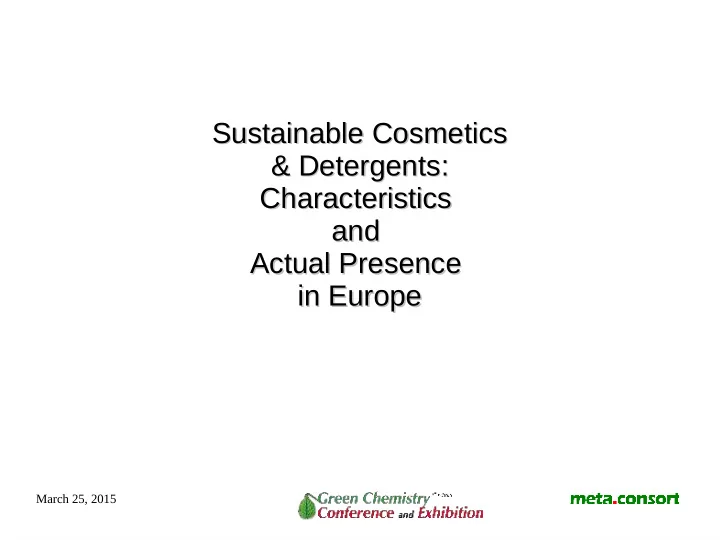

Sustainable Cosmetics Sustainable Cosmetics & Detergents: : & Detergents Characteristics Characteristics and and Actual Presence Actual Presence in Europe in Europe March 25, 2015
Most producers of sustainable cosmetics also offer sustainable detergents and the other way round. Most of them have been founded out of personal interest. March 25, 2015
Similar Ingredient Characteristics ● Sustainable sourcing: – Microbial, plant, (living) animal sources ● Sustainable extraction: – Low energy, low waste processes; principles of 'Green Chemistry', prof. Athanas c.s. ● Sustainable transformation: – Low energy, low waste processes & equipment March 25, 2015
Similar Product Characteristics ● Respectful to human health at use and after – Precautionary principle, NOAEL ● Low environmental impact after use – Low aquatic toxicity, readily biodegradable in all circumstances, no stable leftovers (for washing cosmetics; higher tolerance with detergents) March 25, 2015
Specific for Cosmetics ● Compatibility with human metabolism, the so- called 'bio-compatibility' (bio = life processes) ● For detergents: only when skin contact at application March 25, 2015
Specific for Detergents ● Proven fitness for use: documented performance per category March 25, 2015
Since When? ● First emergence: end of the 19th century in Germany – The Eden Colony, 1893 ● Some of the very first producers: – WELEDA WELEDA (CH), founded 1921 – WALA – Dr. HAUSCHKA (D), founded 1927 – Most of the others: from 1950 onwards March 25, 2015
Why? ● First concern: human health ● Second concern (from 1950 onwards): the global environment – First boost 1962: 'Silent Spring', Rachel Carson – Second boost 1968: Club of Rome – Third boost 1987: Brundtland Report March 25, 2015
How? ● Important research and development activities ● Almost all companies and/or products are certified March 25, 2015
Where? ● Germany is probably lead country (number of companies, turnover, product diversity) March 25, 2015
Conclusions ● Sustainable cosmetics & detergents are a far bigger market segment than we think ● They realise a double digit growth ● They include 'by nature' a strong ethical stance ● They are a partner of choice for the bio-based industry March 25, 2015
Recommend
More recommend